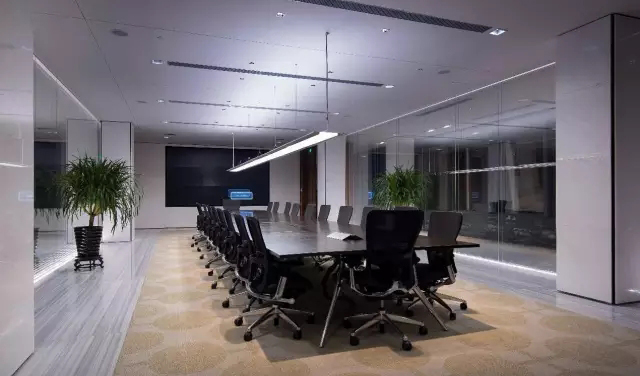What are the functions of a conference room?
Conference room settings will have any number of functions such as mulitimedia presentations, face to face conversations, and video projections. Each of these uses require several types of lighting for the optimal experience. Consider the following lighting design concepts for your office.
First, let’s look at the basic human activities in a conference room:
A conference room is generally used for meetings which require such functions as discussions, presentations, and video meetings. The duration, the communication methods, and the number of participants may vary, but the requirements of each meeting are the same: to encourage & concentrate someone, to comprehend something, to convey ideas and to solve problems.
Based on the requirements, we can roughly conclude the lighting design concepts for a conference room:
The lighting design of a conference room should be communication and innovation-friendly.
Whether the attendees in the meeting are graphic designers, engineers, or financial staff, they all need to be encouraged for imagination. In addition, there are multiple types of meetings, so correspondingly, the lighting environment should be diverse and flexible.
To clearly see one’s face, especially one’s facial expression, is important in a meeting, therefore, the lighting should avoid any shadows or contrasts.
For the lighting of a video conference room, there are particular requirements, because video recording devices are less adaptable than human eyes.
What are the types of the conference rooms?
For meetings other than a video meeting, the lighting environment of a conference room is either "projection on" or " projection off".
So, we can divide conference rooms into two categories:
Video conference room: used for video conferences, business seminars, negotiations, internal trainings, etc.
General conference room: mainly used for communication, also with auxiliary functions such as whiteboard writing and projection.
Based on scale and purpose, conference rooms can also be divided into four categories: video conference rooms, small meeting rooms, medium conference rooms and large conference rooms.

Photo: Video conference room

Photo: Small meeting room

Photo: Medium-sized conference room. The high-color-temperature wall forms a sharp contrast with the low-color-temperature light troughs, offering the room a sense of design. (Source: Conference Room in OPPLE Administration Building at Wujiang Industrial Park) .

Photo: The tiered large conference room. The interior design of this conference room is excellent, for the backrestless seats make people unconsciously maintain the back tension so as to ensure mental concentration. The color temperature of the room can be controlled to meet different requirements. The faint wall light at the back and the embedded light on the steps provide an additional feeling of dimensionality for the whole room. (Source: Conference Room in OPPLE Administration Building at Wujiang Industrial Park)
Then, what are the principles for the lighting design of a conference room?
Principles for conference room lighting design
- Principle of usability
Generally, the lighting design of a conference room needs to focus on the consistency between the lighting environment and the participants.
Desktop conference: mainly for talks, discussions and desk writing. Considering the requirements, desktop illuminance will be the focus of the lighting design.
 Photo: Desktop Conference
Photo: Desktop Conference
Multimedia conference: Compared to desktop conference, it adds auxiliary devices such as projectors and writing boards. For lighting design, designers should notice the switch of conference types and to change the lighting environment accordingly.
 Photo: Multimedia Conference
Photo: Multimedia Conference
- Principle of consistency with the diversity and flexibility of indoor conference table arrangement
The common styles of conference table setting are stage style, classroom style, hollow square style, U style, square style, oval style and round style.

Photo: Stage style (theatre style). The seats are arranged in rows and faced to the podium. The aisles are wide. There are more seats but no place to write.

Photo: Classroom style (school desk style). Seats are placed neatly and flexibly. It can accommodate many people and is convenient to place materials and write.

Photo: hollow square style. Seats are arranged like a hollow square and chairs are placed surrounding the table. Green plants are often placed in the center.

Photo: "U" style. Seats are placed in a U shape and the chairs are placed surrounding the table. Generally no object is placed in the center.

Photo: Square style (Source: Conference Room in OPPLE Administration Building at Wujiang Industrial Park)

Photo: Oval style

Photo: Round table style (Source: Conference Room in OPPLE Administration Building at Wujiang Industrial Park)
- Principle of consistency with interior decoration style
Photo: The original wood-grain lamps are well-matched with the interior decoration style.
- Lighting design principle of overall layout of a video conference room
Conference table: The conference tables are arranged in rows. To reduce surface shadows, it is recommended to use a light-colored tabletop or tablecloth.
 Photo: arranged in rows with light-colored desktop
Photo: arranged in rows with light-colored desktop
To avoid "light distraction" and "light reflection", the must be a separate background wall in beige or gray color and with no framed pictures, so that the camera lens can be set easily.

Photo: There are so many colors on the background wall that it becomes distracting.
 Photo: The background wall is beige and has no framed pictures.
Photo: The background wall is beige and has no framed pictures.
The camera lens should not face to the door. If the door is used as the background, the entrance and exit of any person will cause the camera to over expose the light behind the person.
The color of the background wall should match the colors of the ceiling, the ground and the wall. Black or bright colors should be avoided.Light blue, light gray, light yellow are recommended. Thick curtains should be applied to prevent direct sunlight.

Photo: Thick fabric curtains block direct sunlight.
Note: Unless otherwise indicated, all images are from the Internet.



